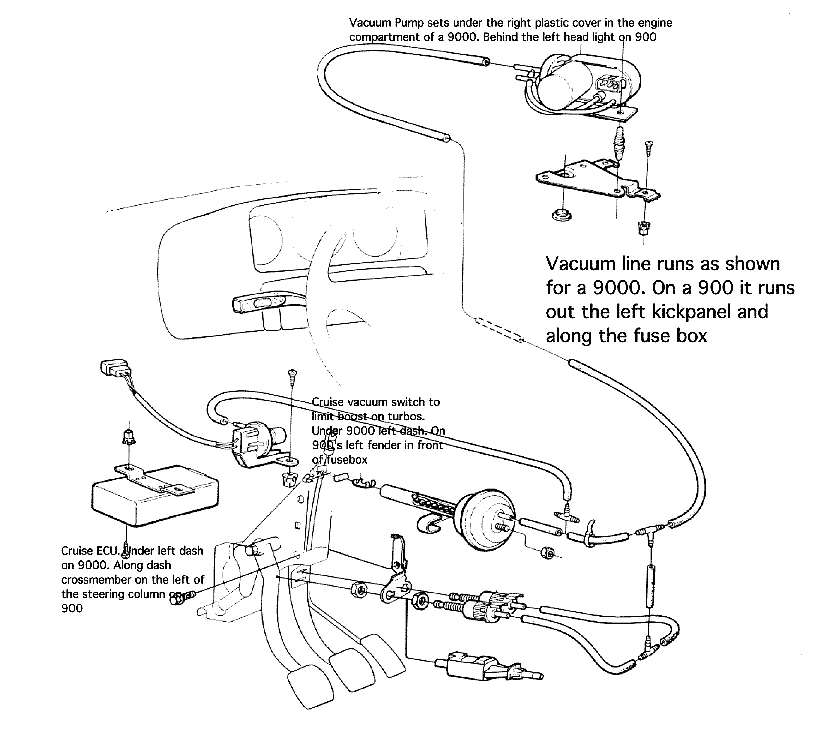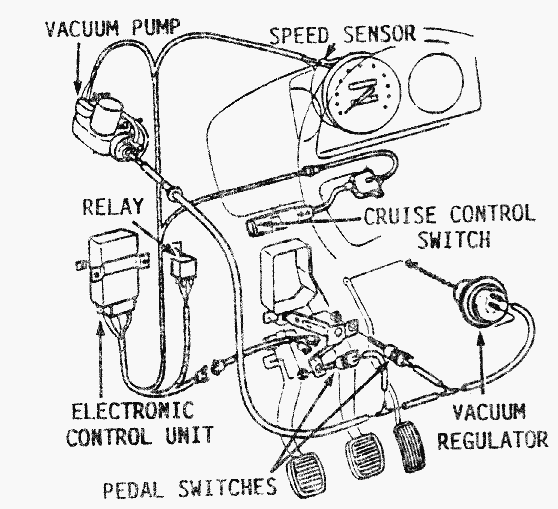

First always check the fuses. Check all of them just to be sure.
Next thing to do is verify the vacuum side of the system is working. Locate the vacuum line running from the pump to inside the car. Of the two ports on the pump projecting forward, only one, the black one should have the vacuum line on it. Look at the pic above or below to see which port this is. The other port is open to allow the vacuum to vent. Remove it from the pump and apply vacuum to the hose (suck on it). The throttle should move at the throttle plate. If so, the vacuum side is good. If not, trace the leak. Likely places are the line itself. they crack especially where the hose bends, like right at the pump or as the hose bends to go into the car on a 900. 9000s seem to have fewer problems except on the very ends of the hose. We replace the hose with a woven encased vacuum line. VWs and Mercedes used this stuff a lot. Its there for a while. Note there are quite a few lines under the dash. You may need to check all of them.
After the lines are traced, check the dump valves on the pedals for misadjustment and not holding vacuum. Try adjusting them
The vacuum servo with the chain attached should hold vacuum and collapse with vacuum applied. As it collapses it pulls the chain attached to the top of the gas pedal, pulling the throttle open. Make sure the chain is attached to the pedal. 9000s had a campaign to place clips at either chain attachment point to secure it. the clips work on 900's as well. Also on a 900, there is a guard that goes on the side of the heater control valve to prevent the chain from getting caught on the screws there. Make sure it is in place, or your car could suddenly run away from you should the chain hang up.
Don't forget to check the boost limiting vacuum switch on the left fender on 900 turbos and under the dash on equipped 9000s. It is a red capped two wire switch with a brown body. It should hold vacuum.

900 (Older components)
92 and up cars have a bit more complicated system. Though similar in component checking,not all test for them are given here. You can trace individual components as here by making measurements at the components, not at an ECU.
As mentioned previously check the fuses. On a 9000 they are Fuses 2, 5, 9 and 24 in the glove box fuse compartment. On a 900, fuses 8,13,22, and 31 are all involved, all in the engine compartment fuse box.
The easiest place to do the tests is to go straight to the ECU and unplug its connector. Pin 1 there, a brown wire, should have 12 V on it with the key on. Pin 8, a black wire, should be grounded at all times. Check between it and pin 1 for 12V. If there, the supply and ground are good.
Pin 2, a red and white wire on a 9000 and a green wire on a 900, should have 12 V anytime the key is on and the cruise switch SET button is depressed. this comes from pin 2 of the stalk switch. If no signal here, check at the rear of the stalk switch. If none there, first check the switches other pins for power and ground as outlined below and if they are present, the switch is bad. See the bulletin on replacing the early stalk switches without a TIP function for modifications necessary to replace it with a newer style switch, the old ones are no longer available.
Pin 3, a red wire, has two functions. When the pedals are released, the dump valves should have continuity through them to ground. The ground circuit passes through the brake light bulbs and grounds at the luggage compartment ground point, at the left rear signal assembly on 9000s and at the ground at the center of the 900 luggage compartment near the spare tire. Should a valve fail to open its circuit if a pedal is depressed, the brake LIGHT switch is wired to this pin as well, so if the brakes were depressed the ECU would get 12 V on this pin and would cancel cruise. If 12V is present at this pin, the cruise will not engage, or will disengage, whether the 12 V comes from the brake switch or from the ground through the dump valves being broken.
Pin 4, a gray wire on a 900 and a 9000 , is 12 V out of the vacuum motor when that the ECU grounds to run the vacuum pump. You can't really check this voltage without driving the car. You can check for continuity from here to pin 2 of the vacuum pump. Seldom is this a problem unless the ECU is bad. Check all others first.
Pin 5, a blue wire on the 900 and a green wire on a 9000 is the speed sensor's input. Look for a varying voltage here while driving the car. Leave this to next to last after confirming all the other readings. If there is no voltage here, first make sure the speed sensor on the back of the instrument cluster is connected. If you have continuity from this pin to pin 2 off the speed sensor on three wire sensor cars, pin 1 of the sensor is getting voltage with the key on from fuse 22 on a 900 and from the ignition switch on a 9000(all the time, key on or off) , and the sensor's pin 3 has a ground, the sensor is bad. On two pin sensor 900s, pin 2 of the sensor is connected here. Pin 1 of these cars' sensor is connected to pin 8 of the ECU.
Pin 6, a yellow wire on a 900 and 9000, should receive 12 V when the cruise stalk switch is held to RESUME. This comes from pin 3 of the stalk switch.
Pin 7 an orange wire, should have continuity to pin 1 of the vacuum pump. This is a control for the pump via its ground supply.
Pin 8, a black wire, is the ground for the ECU. On a 9000, it grounds at the left front speaker on the dash support and on a 900 at the left kick panel ground points.
Pin 9, a red wire is a 12 V feed into the ECU when the cruise stalk switch is turned on.
When the switch is set to ON, 12 V will go out its pin 1 A red wire, to the ECU and to illuminate the CRUISE light in the dash.
Pin 2 of the switch sends 12V to the ECU on its pin 2 when SET is depressed on cars equipped with the later switch with a TIP function in a 900. On earlier 900 switches, the SET voltage goes to a relay mounted beside the ECU. It supplies pin 86 of the relay for its pull down coil. Pin 30 of the relay is connected to pin 2 of the ECU and receives 12 V from it. When the relay gets the 12 V from the SET switch, it connects pin 2 of the ECU to Pin 9 of the ECU, and pin 3 of the vacuum pump. this causes the ECU to set the speed in memory.
Pin 3 of the switch supplies pin 6 of the ECU with 12 V when the RESUME button is depressed.
Pin 4, a brown wire, of the switch should receive 12 V to supply the switch. On a manual transmission car, it comes from the same source as pin 1 of the ECU. On an automatic car, the supply comes through the gear selector switch in the center console. On a 900, this is supplied from fuse 13 to the selector switch pin 2 via a orange wire and comes out the selector switch on pin 3. On a 9000 auto, it is supplied from fuse 9 to pin 3 of the selector switch and out pin 4 of the switch. This also the idle up circuit for the engine speed when engaging gears, either reverse or drive. So the feed is present when the car is put into gear.
If the cruise still doesn't work and has all the pin checks good, the
ECU is probably to blame .
For cars that gain or lose speed, check the chain on the pedal, and for any vacuum leaks, but generally this is either a speed sensor or a ECU problem. To find this for sure, you would have to monitor those signals while driving and see which was changing.
To a brief TCS differing function bulletin